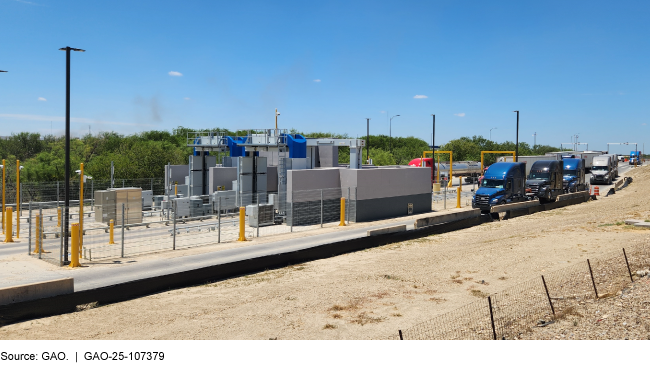Land Port Inspections: CBP Should Improve Performance Data and Deployment Plans for Scanning Systems
Fast Facts
U.S. Customs and Border Protection uses scanning systems to detect illegal drugs and other contraband at land crossings. CBP is deploying additional X-ray systems with a goal of scanning all vehicles crossing the border.
However, CBP's deployment plans exclude 9 major crossings that account for nearly 40% of passenger vehicle traffic at the southwest border. In addition, CBP hasn't defined key performance measures it needs to evaluate the new scanning systems.
We recommended that CBP clearly define its performance measures and determine how to include all southwest land border crossings in its deployment plans.
X-ray Scanning Systems in a Commercial Vehicle Crossing

Image of X-ray systems at a commercial vehicle crossing—they look like toll lane infrastructure.
Highlights
What GAO Found
U.S. Customs and Border Protection (CBP) uses non-intrusive inspection (NII) systems, such as X-ray machines, to inspect vehicles and travelers at land ports of entry (POE). As part of this process, CBP officers use large-scale NII systems to scan entire vehicles and their contents. These scans produce images that CBP officers review to help detect illegal drugs or other contraband. In 2020, to increase vehicle scans, CBP began deploying these systems to preprimary inspection areas—before a traveler is interviewed by a CBP officer. Previously, NII systems were generally used only when an officer determined that further inspection was required after the interview.
Non-Intrusive Inspection Systems Deployed in the Preprimary Inspection Area at the Bridge of the Americas, El Paso, Texas

CBP uses performance data to help ensure large-scale NII systems are operational, but it has not defined all key performance parameters for NII systems. For one key parameter, CBP reports and uses data on the percent of time that large-scale NII systems are available for operational use. However, CBP has not clearly defined or reported results for its other two key parameters related to inspection rate and examination of containers and cargo. For example, CBP’s inspection rate parameter requires 100 percent inspection of high-risk commercial vehicles and container cargo, but CBP has not clearly defined the term high risk. Clearly defining and reporting results for all of its key performance parameters would help CBP manage the NII program and inform future procurement decisions.
CBP has made progress deploying large-scale NII systems. As of February 2025, 52 of 153 planned systems are fully operational, nearly all at preprimary inspection areas. Deployments have cost more than CBP estimated due to, for example, unexpected construction challenges. Congress directed CBP to develop a plan to achieve 100 percent scanning of commercial and passenger vehicles and rail containers at land POEs using large-scale NII by 2027. However, some POEs lack installation space and CBP’s plans for the southwest border omit nine passenger vehicle crossings that together account for nearly 40 percent of passenger vehicle traffic at that border. Without these crossings in its plan, CBP risks entry of many unscanned passenger vehicles, hampering its ability to prevent illegal drugs and other contraband from entering the U.S.
Why GAO Did This Study
Since 2019, CBP has received over $2 billion that they have used to deploy additional NII systems to land POEs, which are a key drug smuggling route.
GAO was asked to review the implementation and effectiveness of CBP’s NII program. This report examines (1) how CBP uses NII systems during inspections at land POEs, (2) CBP’s assessment of large-scale NII performance, and (3) the status of large-scale NII system deployments.
GAO analyzed NII program documentation, including inspection procedures, performance data, and deployment plans, and interviewed program officials. GAO also interviewed and observed CBP officers conducting inspections at land POEs within all four field offices where large-scale NII systems had been deployed in preprimary inspection areas. These POEs included a variety of large-scale NII systems and types of crossings (passenger and commercial vehicles, and rail) along the southwest border. GAO also interviewed officials at a northern border field office that was in the process of deploying new large-scale NII systems.
Recommendations
GAO is making two recommendations, including that CBP clearly define and report results for its key performance parameters, and determine how to include deployment of large-scale NII systems to all southwest land border ports of entry in updates to the deployment plans. DHS agreed with both recommendations.
Recommendations for Executive Action
| Agency Affected | Recommendation | Status |
|---|---|---|
| United States Customs and Border Protection | The Commissioner of CBP should clearly define all NII key performance parameters and report performance using them. (Recommendation 1) |
When we confirm what actions the agency has taken in response to this recommendation, we will provide updated information.
|
| United States Customs and Border Protection | The Commissioner of CBP should determine how to include deployment of large-scale NII systems to all southwest border land POEs in updates to its deployment plans. (Recommendation 2) |
When we confirm what actions the agency has taken in response to this recommendation, we will provide updated information.
|
